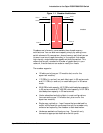
Cajun P550R/P880/P882 Switch User Guide
Introduction to the Cajun P550R/P880/P882 Switch
1-5
Figure 1-1. Crossbar Architecture
Crossbars are inherently more scalable than shared memory
architectures. You can add more capacity simply by adding more
switch elements. By comparison, shared memory switches have an
inherent maximum upper boundary in throughput that makes
high-density, single-backplane gigabit switches impractical. This
means that as you increase the number of gigabit ports in your
network, the architecture can scale to meet your needs.
The crossbar supports:
■ 13 fabric ports (two per I/O module slot, one for the
supervisor module).
■ 1.76 GB/s (in and out) on each fabric port in 50-series mode
and 2.11 GB/s (in and out) on each fabric port in 80-series
mode.
■ 22.88 GB/s total capacity, 45.76 GB/s total backplane capacity
in 50-series mode and 27.455 GB/s total capacity, 54.91 GB/s
total backplane capacity in 80-series mode.
■ Under-subscribed switching fabric in most configurations
(two connections per I/O module slot, plus one for the
supervisor module).
■ Single copy replication - Input frames that are destined for
output multiple switch ports pass through the crossbar only
once and are copied by the crossbar to each destination.
■ Hardware-assisted multicast pruning - The switch only
forwards to appropriate destination switch ports.
Crossbar
Port 1
Port 2
Port 13
1.76 Gb/s
22.88 Gb/s
Port 1
Port 2
Port 13
1.76 Gb/s


















